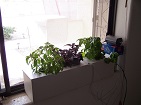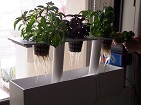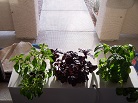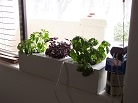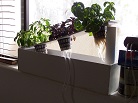Have
you ever wanted to have your own window herb garden? Growing those live
fresh herb plants so you can have them on hand to add them to your
dishes. If you have a window that gets a good amount of sunlight y
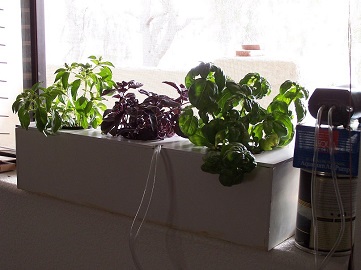
ou
have a great space grow them in. If not, you can still grow them on a
patio, in the backyard, on the side of the house, on a balcony etc..
And you don't need to buy a $100-$200 hydroponic system to do it
either.
I basically just built this system from what I had
lying around. You don't need to build your box out of exactly the same
materials as I did. You can make your grow box from lots of different
things, like storage totes and plastic containers, plexiglass or
Acrylic Sheets etc.. If it fits on your window sill (or wherever you
want it to go), and holds at least 1 gallon of water per plant it will
work. Just make sure if it's not already, you make it light proof or
you will get algae growth inside the box and in your nutrient solution.
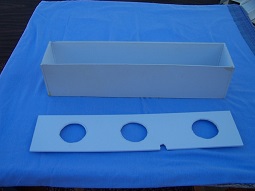
Parts List
- Waterproof box with top
- Duel output aquarium air pump
- Aquarium air line tubing
- 2 "T" connectors for air line tubing
- ¼ inch soaker hose (or aquarium air stones)
- ½ inch PVC tubing
- Four ½ inch PVC elbow connector
- Zip ties
- Three, 3 inch baskets, pots, or plastic cups for the plants
- Growing medium of some type
The Herb Garden Box
I
built the trough and lid (grow box) out of a sheet of "Expanded Foam
PVC." it comes in 4 by 8 foot sheets of different thickness like
plywood. Except the Expanded Foam PVC is plastic and waterproof. It's
like PVC tubing , but in a flat sheet. It's not a common material
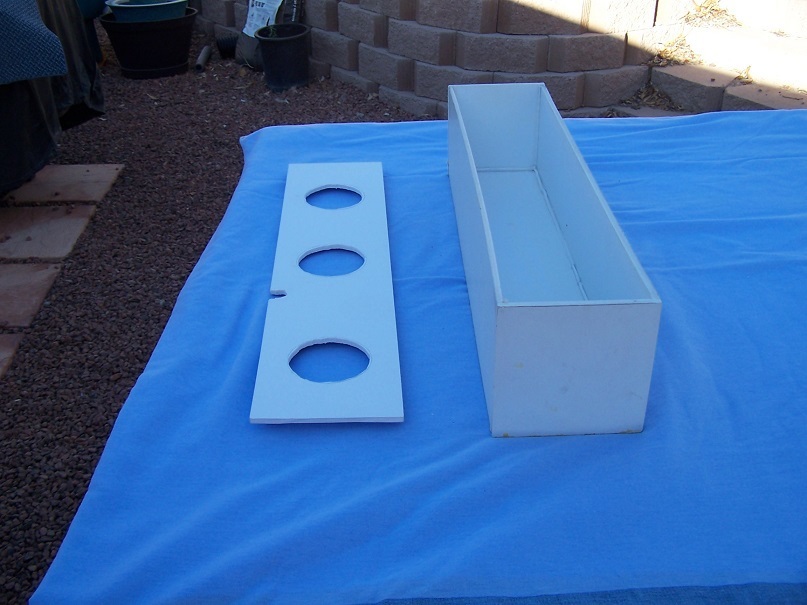
,
but you can probably get it from most sign company's. That is company's
that build signs for businesses. They use it in their industry. Also
it's not a cheap material, it can run over $50-$60 for one 4x8 sheet,
1/4 inch thick (6 mm). But you don't need anywhere near a whole sheet,
and you could probably buy scraps for what you need from the sign
company's cheap (or even get it free). I like it because I can
make custom size containers to fit any space.
There are a few
ways to glue it together. If you plan to work with it a lot, there is a
special PVC glue and applicator for it. Called "Weld-On 2007." It's
water thin, and the applicator is used to apply it along the edges
touching each other. Then just hold in place for 30 seconds or so. But
unless you have perfectly straight cuts it still wont hold water
because the glue isn't designed to fill gaps. You can fill the gaps
with another PVC adhesive called Bond Fill. The Bond fill is like a
liquid PVC that fills gaps, but it's a little pricey as well and you
will probably need to order it online from the manufacture.
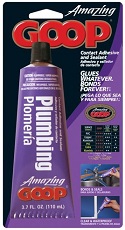
However
if you do use the sheet PVC to build your herb garden system, it will
probably be much cheaper and easier for you to just use super glue
instead of the Weld-on 2007 to put the box together (sort if tack
welding the box together). Then apply a good bead of pluming goop along
the seams inside the box to fill and waterproof any gaps along them, as
well as providing more structural stability for the box.
I
attached a couple of one inch wide , ½ inch tall blocks underneath the
the lid at the ends. These blocks keep the lid in place and keep it
from sliding off, and/or out of place. Then I made
a template
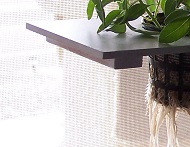
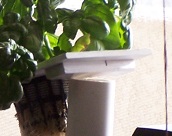
just smaller
than the 3 inch baskets I used for the plants, and drew the holes on
the lid with it. Then just cut out the holes for the plants out using a
rotary tool (I don't have a hole saw that size).
The Bubbling System
This
window herb garden system is essentially a small water culture
hydroponic system. The air bubbles are important so the roots don't
suffocate from being submerged in the nutrient solution 24/7. The more
air bubbles you give them, the better the plants will be able
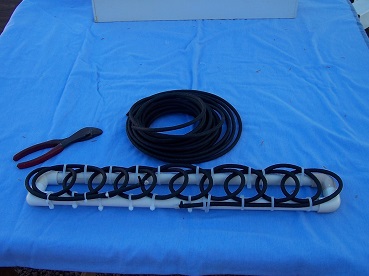
to
do. Especially as the plants get bigger and thus use more oxygen. You
can use standard aquarium air stones in this system if you want, but
it's hard to get an even amount of air bubbles under each plant. So I
opted to make my own air stone system so they would be evenly
distributed.
To make my own bubblier system, I used standard
1/4 soaker hose to make the bubbles. It can be found at most home
improvement stores, and even walmart with the plant irrigation
supply's. But because the soaker hose floats, especially when filled
with air, I needed to weigh it down. I also needed something to tie the
soaker hose to so it would hold the shape I wanted. To solve both
things I built a frame out of 1/2 inch PVC tubing and elbow connectors.
I just measured the inside of the box and cut the PVC tubing to
easily fit in it. I dry fitted the pieces together and placed it inside
to make sure it still fit correct. Then I opened up one side and filled
the inside of the PVC tubing with sand to make it heavy. If you don't
have sand, you can use dirt or small rocks. Then I put it back
together. I didn't glue the PVC joints together because I taped it
together with a rubber mallet and it fit very tight, but you can glue
them if you want, or need to.
Once I had the bubblier
frame together I took one end of the soaker hose and zip tied it
about the middle of the PVC frame. Then ran it to one end of the PVC
frame and zip tied it again. Then just made small overlapping loops all
the way across, zip tying each loop on

both
sides as I go. Once I had it looped all the way across, I then ran the
end straight to the center again like the other side.
Connecting the air line to the soaker hose
If
you can find elbow connectors for the air line, use those. I didn't, so
I modified "T" connectors instead. To do that was simple. I just cut
one side of the "T" connector off and

plugged
the opening with JB weld. If you don't have JB weld, you can use,
pluming goop, silicone, or any type of waterproof glue or adhesive to
plug the opening.
Once it has completely dried, insert
the modified "T" connectors into both ends of the soaker hose. Then
connect the air line from the duel output air pump to the
modified "T" connectors. One air line to each side of the soaker hose
The
air pump comes with one way check valves. But don't use them, they can
clog and block air from getting to your plants. Instead just make sure
the air pump is always at least 5-6 inches above the water line, that
will keep water from getting into the air pump, even if it
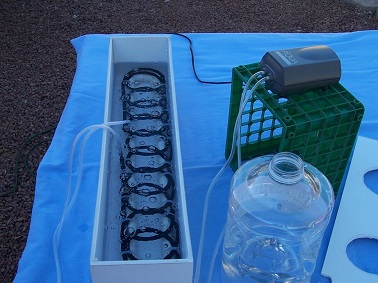
looses power for some reason.
The
air pump comes with one way check valves. But don't use them, they can
clog and block air from getting to your plants. Instead just make sure
the air pump is always at least 5-6 inches above the water line, that
will keep water from getting into the air pump, even if it looses power
for some reason.
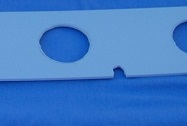
Now
go ahead and place the bubblier system in the grow box, fill it with
some water and plug in the air pump. The soaker hose bubblier system
not only distributes the bubbles evenly throughout the water, but it
also gives smaller bubbles which is more beneficial for the plants.
Growing the plants in your window herb garden
You
can use standard baskets for hydroponics like I did, or small pots, or
even plastic cups to put the plants in. The 3 inch wide baskets I used
you can get at any hydroponics shop for l
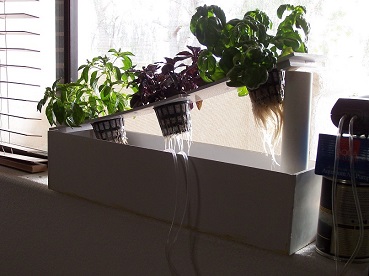
ess than a buck a piece.
I
used coco coir for the growing media in this herb garden system because
it's what I had on hand. I would have preferred using coco chips
instead, it's made from the same material (coconut husks), but the coco
chips are much larger pieces. Those larger pieces wouldn't fall through
the slats in the baskets. To keep the coco coir from falling through
the slats, I needed a screen. I lined the inside of the baskets with a
fine mesh drywall tape before filling it with the coco fiber. But if
you use the same growing media that I did, you can use any type of
screening that you have, even cheesecloth will work as a screen. You
can learn more about different types of growing media on the
growing media page.
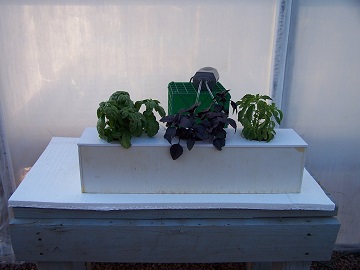
At
first there won't be any roots growing out of the bottom of the
baskets, so you will want to make sure the water level is high enough
so the growing media in the baskets remains moist at all times or the
roots wont get any moisture. As the plants get bigger, the roots will
grow down into the nutrient solution, as well as wick up water to the
growing media.
As the plants drink up the water, you'll need
to replace it with fresh water (not nutrient solution), And change your
nutrient solution every couple of weeks, or every week when the plants
are bigger.
Happy Gardening!!!

